and historical purposes, all rights reserved.
This page is copyright© by
This page may not be sold or distributed without the
expressed permission of the producer.
I have no connection with any camera company.
This camera manual library is for reference
and historical
purposes, all rights reserved.
This page is copyright© by ![]() ,
M. Butkus, NJ.
,
M. Butkus, NJ.
This page may not be sold or distributed without the
expressed
permission of the producer.
I have no connection with any camera company.
On-line camera manual library
If you find this manual
useful,
how about a donation of $3 to:
M. Butkus, 29 Lake Ave.,
High Bridge, NJ 08829-1701
and send your
e-mail address
so I can thank you.
Most other places would charge
you $7.50 for a electronic copy
or $18.00 for a hard to read Xerox copy.
buy new manuals,
and pay their shipping costs.
It'll make you feel better, won't
it ?
If you use Pay Pal, use the link below.
Use the above address for a
check, M.O. or cash.
Back to main camera manual page
CLICK HERE TO GO TO A
PDF VERSION OF THIS
Ricoh Shotmaster AF Super PAGE

CONTENTS
|
Locating the controls 3 Using the strap 5 Inserting the battery 6 Opening the lens shield 8 Checking the battery 9 Loading the film 11 Setting the film speed 14 Holding your camera 15 Viewfinder 16 Auto-focus shooting 17 Pre-focus shooting 19 Rewinding the film (Auto reverse) 21 Flash photography 23
|
Using the self-timer 25 The feature mode 27 Using the panorama mode 29 Using the night photography mode 30 Using the TV mode 31 Using the continuous shooting mode 32 Using the interval mode 35 Using the ME mode 37 Remote control socket 38 Proper care of your camera 39 Specifications 40 |
 |
The camera will not operate unless the battery is installed. It is important
to make sure that the battery is installed correctly. 1. Push the Battery
Compartment Cover Latch by a pen etc. in the direction of the arrow and pull
open the cover. (Fig. 3)
|
 |
* When the battery is inserted correctly, the Battery Condition Mark WE
appears on the LCD Control Panel when the Lens Shield is opened. (Fig. 6)
* When replacing the battery, do so as quickly as possible, and avoid having
film inside the camera.
* Do not remove the battery from the camera unless it is to be replaced with a new one. |
Battery for use
Lithium battery (6 V) Panasonic CR-P2DR
OPENING THE LENS SHIELD
 |
1. Open the Lens Shield by sliding the Lens Shield Switch toward the mark of
(A (opening). (Fig. 7)
|
* Opening the lens shield while pressing the shutter release will
release the shutter.
CHECKING THE BATTERY
 |
1. The battery icon symbol is displayed on the LCD Panel when the battery power is sufficient. (Fig. 8) 2. When the battery is nearly exhausted, the ~ symbol will appear. (Fig. 9)
3. When the battery is completely exhausted, the c symbol will be displayed.
(Fig. 10)
Replace with a new battery.
* Cold temperatures will reduce battery efficiency. In freezing weather, the
~ symbol may turn off and only the can or c symbol may show in the LCD panel.
When the camera returns to normal temperature, the Battery "All Right"
symbol should reappear. If you are taking pictures in cold weather, keep the
camera warm and take it out only when you need it.
* When the empty battery symbol is shown in the LCD Panel, don't use the flash. |
* If the battery voltage is insufficient, the shutter may not
release or the film may not advance completely. In the following cases, replace
the battery:
1) When the battery mark displays only the outside of the frame (no black in battery icon).
2) When the shutter does not release.
3) When it takes 10 or more seconds for the Flash Ready Lamp to light.
4) When film advance and rewind cannot be done.
5) When the self-timer does not function.
6) When the battery has been in the camera for 5 years or longer.
LOADING THE FILM
 |
Always avoid direct sunlight when loading the film.
1. Push the Back Cover Latch downwards to open. (Fig. 11)
2. Load the film cassette into the Film Chamber and pull out enough film leader to extend over the mark of the film leader position ( - ). (Figs. 12.A, 12-B)
|
3. Please make sure that the film is within the Film Guides (Fig. 13), and
that the film is not slack. (Fig. 14)
 |
4. Press the Back Cover shut so that the Back Cover Latch returns to its
original position. The film is automatically advanced until number "1" appears
in the LCD Panel. As soon as you close the Back Cover, the LCD Panel will show
the following signs. (Fig. 15)
3. Exposure Counter
|
 |
5. If the film has not advanced correctly and is not taken up onto the Film Take-up Spool, the Film Cassette Loaded Symbol, the Film Advance Symbol and Exposure Counter will blink for about 30 sec. (after 30 sec., they appear without blinking but start to blink when the Shutter Release Button is pressed and the shutter can not be released). Please reload the film by following steps 1--4 shown above. (Fig. 16) * Whether there is film in your camera or not can be confirmed by either the Film Loaded Window or the cartridge symbols in the LCD Panel. (Fig. 17) * Do not use special-purpose films such as 35 mm Instant Reversal Film, etc. because your camera may not be able to transport and expose them properly. * You can load film in your camera although the Lens Shield is closed. However, the LCD display is not shown. |
SETTING THE FILM SPEED
 |
DX coded films are provided with black-and-silver patterns corresponding to
film speeds which the camera reads and automatically sets. Your camera accepts
DX films with speeds ranging from ISO 100 to 1600.
|
HOLDING YOUR CAMERA
 |
1. Use both hands to steady your camera. (Figs. 19, 20)
2. Be careful not to place your fingers over the lens, flash, or focusing
windows. (Fig. 21)
* When holding vertically always position it with the flash at the top.
|
VIEWFINDER (Fig. 22)
 |
1. Field of View Frame:
|
AUTO-FOCUS SHOOTING
 |
1. Set the subject you wish to take within the Auto-Focus Frame in the center of the Viewfinder. (Fig. 23) 2. When you press the Shutter Release Button halfway, the AF monitor will light up. If the AF monitor blinks (When the subject is closer than 0.8 m (2.6 ft.)), you should move back a little as your camera is too close to the subject. (Fig. 24) * The AF monitor may light steadily if the subject is 0.4 m (1.3 ft.) or closer to the camera Releasing the shutter in this case will result in an out of focus picture. Therefore, let go of the Shutter Release Button and adjust your distance to make sure the subject is at least 0.8 m (2.6 ft.) away from the camera. Then point at the subject once again and press the Shutter Release Button. |
3. Gently press the Shutter Release down to take a picture. The film will
advance automatically after the shutter teas been released.
* Avoid pressing the Shutter Release Button too abruptly to avoid camera shake
or possible mis-operation.
* Please be careful not to accidentally cover the Distance Measuring Windows at
the front of your camera, as this will cause the incorrect focusing.
* Please keep the Distance Measuring Windows clean so that focusing is accurate.
If they get dirty, they should be wiped clean with a soft cloth.
* There may be rare cases where the subject cannot be well focused. (For
instance, dark subject that do not reflect light well, glossy subjects, or
subject taken through glass.) In the cases, it is best to use the Pre-Focus
technique to "lock" the focus on a more "normal" subject at the same distance.
While holding focus, turn your camera back to the original subject and shoot.
(See PRE-FOCUS SHOOTING for more details.)
PRE-FOCUS SHOOTING
 |
When the main subject you wish to focus on is not within the Auto-Focus
Frame, or if the subject is difficult to focus on, then you should use pre-focus
shooting.
|
When the subject is difficult to focus on:
1. When you are photographing subjects that are difficult to focus
on (such as a black dog, glossy surface or behind glass), find another subject
at about the same distance from the camera. You can pre-focus on that subject in
the same way as described front page.
* If you are shooting through a window, aiming the camera at a slight angle to
the glass usually avoids any direct reflection of auto-focus beam.
* When you remove your finger from the Shutter Release Button, the pre-focused
condition is cleared, so that you can pre-focus again as many times as you wish.
REWINDING THE FILM (AUTO REVERSE)
 |
1. After the end of the film has been
reached, the film is automatically rewound.
|
 |
* If you wish to rewind the film before the end of the film is reached, push
the Manual Film Rewind Button with a pen, etc. (Fig. 30)
|
FLASH PHOTOGRAPHY
 |
1. If flash is required, the Flash Unit automatically pops up when the
shutter Release Button is pressed halfway and its power source automatically
turns on. (Fig. 32)
2. Release the Shutter Release Button completely and wait for the Flash Ready
Lamp to become lit. Then take the picture. (Fig. 33)
(If the Shutter Release Button is then pressed before the flash is ready, the
shutter will be released immediately after the flash becomes fully charged.)
|
 |
* After the Flash Unit pops up, it will take about 2 seconds to charge. For
the next 5 minutes, flash recharging will continue to allow a constant flash
capability. However, to prevent battery drain, if no flash pictures are taken
for 5 minutes, flash recharging will stop and the Flash Ready Light will go off.
Even after recharging stops, when the Flash Unit is left popped up, it will
start to recharge again when the Shutter Release Button is pressed halfway.
|
USING THE SELF TIMER
 |
1. Press the Self-timer Button. The Self-timer LED on the front of your
camera will light for approximately 8 seconds. Then, the LED will blink for
about 2 seconds to indicate that the shutter will release soon. After a total 10
seconds have elapsed, the shutter will release. (Figs. 37, 38)
* If you wish to clear the self-timer once it has started, close the Lens Shield or press the Self-timer Button again. |
Using the Self-timer for Flash Photography:
a. The Flash Unit will pop up automatically when the Self-timer Button is
pressed if there is insufficient light.
b. Wait for the Flash Ready Lamp to light.
c. Press the Self-timer Button again (the camera will focus) to make the
exposure as described above.
* For backlit subjects within 3 m from the camera, the Flash Unit will pop up
automatically.
Using the Self-timer for Pre focus Photography:
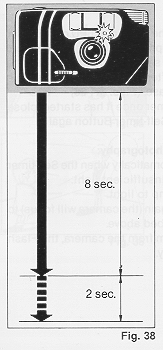 |
a. Select the subject you wish to pre-focus on. Move the camera so that it is
in Auto-Focus Frame.
b. Press the Shutter Release Button halfway down to adjust and lock-in the
focus.
c. While holding the Shutter Release Button halfway, press the Self-timer
Button to activate the self-timer.
d. The focus will remain fixed at the locked-in distance until the photograph is taken. |
THE FEATURE MODE
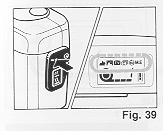 |
This camera has a variety of operating modes which permit you to widely
express your creativity. These modes include Panorama, Night Photography, TV,
Continuous Shooting, Interval, and Multiple Exposure (M.E.).
|
* To change operating modes, simply press the Mode Button. Each time it is
pressed, the camera will be set to the next mode. (Fig. 39)
You can confirm that the desired feature mode is in effect by
checking the LCD Panel which displays the current feature mode. The following
symbols are used for the respective modes as listed below. For detailed
operation of each mode, refer to their respective sections in this operating
instructions.
Feature mode symbols (Fig. 40)
 |
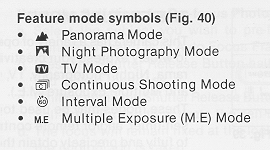 |
USING THE PANORAMA MODE
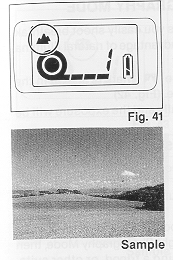 |
By using Panorama Mode to shoot landscapes or long-distance objects, you can
achieve even sharper images. (Refer to sample photo.)
|
* The Flash Unit will not fire even if the Flash Ready Lamp is lit.
(Since the flash will not reach the subject anyway, battery power
is conserved.)
* To cancel the mode, press the Mode Button to set the camera to normal mode
(when the LCD Panel displays no mode symbols) or close the Lens Shield.
* To use the self-timer in this mode, press the Mode Button until the camera is
set to the Panorama Mode, then press the Self-timer Button.
USING THE NIGHT PHOTOGRAPHY MODE
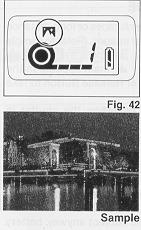 |
This Night Photography mode lets you easily shoot breathtaking evening
panoramas that take advantage of natural illumination. (Refer to sample photo.)
|
| ISO | SHUTTER SPEED | f-stop |
| 100 | 1/4 sec. | 3.5 |
* The Flash Unit does not pop up under the Night Photography Mode.
* To use the self-timer in this mode, press the Mode Button until the camera is
set to the Night Photography Mode, then press the Self-timer Button. Using a
tripod, or other suitable firm support, is recommended to prevent camera shake.
* To cancel this mode, press the Mode Button until the LCD Panel shows no mode
symbol, or close the Lens Shield.
* If flash is up, it will not work.
USING THE TV MODE
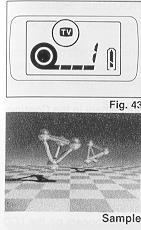 |
Use this mode to shoot the screen of a computer monitor or television. (Refer
to sample photo.)
* The Flash Unit does not pop up under the TV Mode.
|
* To cancel this mode, press the Mode Button until the LCD Panel shows no
mode symbol, or close the Lens Shield.
* If flash is up, it will not work.
USING THE CONTINUOUS SHOOTING MODE
 |
This mode allows you to shoot continuously as long as the shutter is pressed.
|
2. Press and hold down the Shutter Release Button. Your camera will
continuously take pictures at a rate of one frame per second as long as the
Shutter Release button is held down. (Fig. 45)
3. Press the Mode Button to cancel the Continuous Shooting Mode. Confirm that
the Hi mark disappears on the LCD Panel.
* If you want to cancel the Continuous Shooting Mode before taking any picture,
press the Mode Button again until the mode marks go off, or close the Lens
Shield.
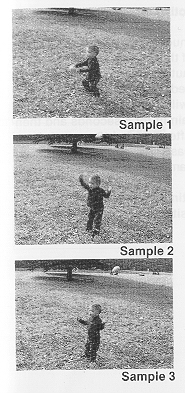 |
Combining the Continuous Shooting Mode and the Self-timer:
2. Press the Shutter Release Button halfway down.
|
5. Continue shooting by holding down the Shutter Release Button. Your camera
will automatically make another exposure each time the Flash Ready Lamp
relights.
6. Press the Mode Button to cancel the Continuous Shooting Mode, and push the
Flash Unit down to the original position.
Combining the Continuous Shooting Mode with the Self-timer and
Flash:
1. Set the camera to the Continuous Shooting Mode.
2. Press the Self-timer Button. If the amount of light is insufficient, the
flash will pop up automatically.
3. When the flash is fully charged, again press the Self-timer Button. The
Self-timer LED will light.
4. The Self-timer LED will remain lit for 8 seconds and then start to f lash for
2 seconds. After a total of 10 seconds have elapsed, the shutter will release.
5. As soon as the Flash Ready Lamp comes on again, the shutter release a second
time.
6. Cancel the Continuous Shooting Mode and push the Flash Unit down to the
original position.
USING THE INTERVAL MODE
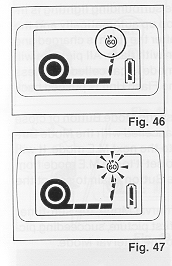 |
This mode closes the shutter in 60-second intervals.
3. Press the Mode Button to cancel it, or close the Lens Cover. Confirm that the (60) mark disappears. |
* When the Interval Mode is activated by pressing the Shutter Release Button,
the symbol that was displayed on the LCD Panel will blink (Fig. 47)
* At the end of the roll, your camera will automatically rewind the film and
reset to the normal condition.
* You can also release the shutter during the Interval Mode.
(If the Interval Mode is not cancelled, the shutter will be released again 60
seconds after it was last released.)
 |
* When in the Interval Mode, if the surrounding lighting is insufficient, the
Flash Unit will pop up automatically and the Interval Mode will be activated
after the flash is charged and ready. Pictures will then be taken with flash.
All pictures will be taken with flash unless the mode is cancelled or unless
there is sufficient lighting and the Flash Unit is pushed back down.
|
USING THE MULTIPLE EXPOSURE (M.E) MODE
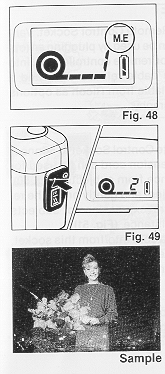 |
The multiple exposure capability is used to take several different images on
the same film frame.
|
REMOTE CONTROL SOCKET
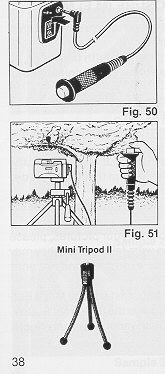 |
This camera is equipped with a Remote Control Socket. Various methods of remote control can be used by plugging an (optional) infrared sensor, audio sensor, remote controller, etc.. into this socket. A 50 cm electronic cable release cord, and a 10-meter extension cord, are available from Ricoh as options for use in remote control photography Typical installation
|
Mini Tripod II (Sold separately)
Lightweight, compact, and easy to carry around. For self
timer, interval, and slow shutter speed picture taking.
PROPER CARE OF YOUR CAMERA
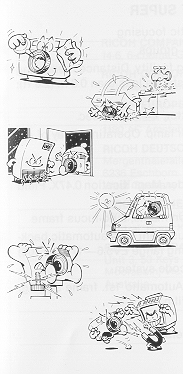 |
* If there is dirt on the lens or Distance Measuring Windows, do not touch
with fingers. Use a blower to blow the dust away, or wipe the surface gently
with a soft cloth.
|
MAJOR SPECIFICATIONS: RICOH SHOTMASTER AF SUPER
Type:
35 mm lens shutter type with automatic focusing
Lens:
35 mm f3.5 Ricoh lens 4 elements, 4 groups
Focusing:
Automatic focusing with pre-focusing facility. Distance
measuring (shooting) range: 0.8 m (2.6 ft) - Distance less than 0.8 m (2.6
ft): AF monitor lamp blinks
Shutter: Programmed AE type electronic shutter, 1/4--1/400 sec.
Self timer: Built-in electronic type with self-timer lamp. Operating delay of approx. 10 sec.
Interval Timer: Photography at 60 sec. intervals
Viewfinder:
Al bade type with bright-frame viewfinder. Magnification
0.47X. Field of view 84%
Viewfinder Information:
Field of view frame, parallax correction marks,
auto-focus frame
Exposure Adjustment:
Programmed automatic exposure adjustment with
automatic back light control system. Exposure coupling range EV5.6--17 (ISO 100)
Film Speed Range: ISO 100--1600. Compatible with DX-code system
Film Advance/Rewind: Automatic film advance and rewind. Automatic 1st. frame setting.
Automatic film reverse at the end of film.
Film Loading: Ricoh Auto-Load system
Exposure Counter: Additive, counts down during film reverse LCD Display: Film loaded, film advance, exposure counter, film reverse and reverse completion, battery condition, landscape mode, night scene mode, continuous mode, interval mode, multi-exposure mode, TV mode
Built-in Flash: Electronic flash automatically activates in dim light and backlight
Interval Between Flashes: About 2 sec.
Power Source: 1 lithium battery, CR-P2DP (6 volts) or equivalent
Dimensions: 121 mm (W) x 67 mm (H) x 44 mm (D)
Weight:
220 9 (without battery)
Specifications and appearance of this camera are subject to change without
notice.